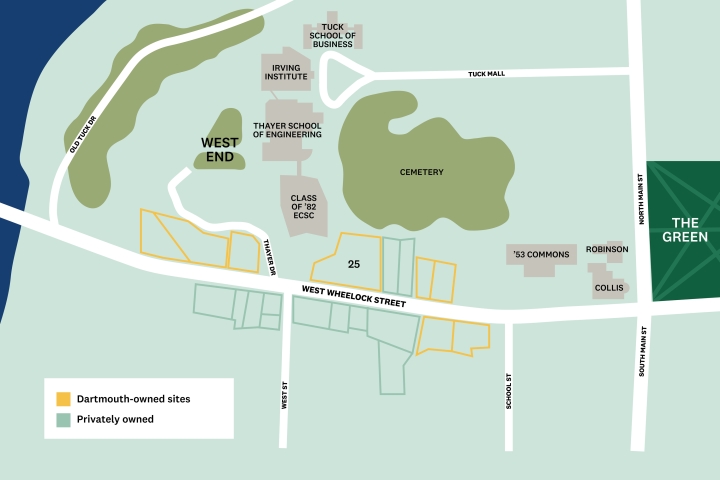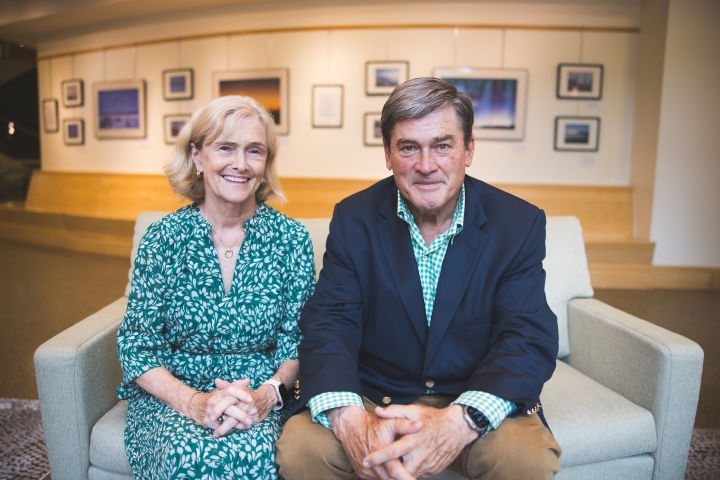At the fall meeting of the Board of Trustees, President Sian Leah Beilock and her team advanced a comprehensive housing strategy—a once-in-a-generation, $500 million investment in new and renewed undergraduate housing that is modernizing existing residence halls and helping to fulfill her pledge to add a combined 1,000 beds for students, faculty, and staff over the next 10 years.
“We have a historic opportunity to sustainably expand and reimagine the infrastructure for residential student housing that supports our academic mission and preserves the walkability of campus and the small-town character of Hanover,” President Beilock says.
In support of this effort, Beilock announced that Dartmouth has received the largest gift for undergraduate housing in its history—$30 million from Thomas A. Russo ’77 and Gina T. Russo ’77. The apartment-style residence hall for juniors and seniors being built at 25 West Wheelock Street will be named Russo Hall in their honor.
The announcement of the Russos’ generosity launches a $165 million fundraising campaign that will raise private gifts to help fund the construction of Dartmouth’s first new undergraduate residences in more than 20 years. This campaign is part of Dartmouth’s overall $500 million investment in undergraduate housing.

“It is crucial that we create more high quality, energy efficient housing on and around campus in order to attract the best talent to Dartmouth at every level—student, faculty, and staff—and to help alleviate the shortage in our region,” Beilock says. “At a time when our society is facing both a climate crisis and what the surgeon general calls an epidemic of loneliness, we are designing housing that will help foster wellness, social connection, and belonging while reducing our carbon footprint.”
The new opportunities in the West Wheelock corridor, as they are developed, will free up housing for graduate and professional school students. And, as part of Beilock’s call for additional housing for all Dartmouth populations, details will be announced later this year on investment in faculty and staff housing.
Housing: A Top Priority
Investment in housing is one of the major priorities Beilock outlined a year ago in her inaugural address. The strategy announced this week includes the continued renewal of existing undergraduate housing in the next decade and the development of West Wheelock Street into a new residential corridor—complete with green space and pedestrian and bike paths connecting to the West End and central campus—that will serve as a gateway to the campus and town.
A goal of the housing program is to offer on-campus beds to more than 90% of undergraduates. Currently 85% of undergraduates live on campus.
All of the housing is being designed to help Dartmouth achieve the decarbonization goals established by the Dartmouth Climate Collaborative, a separate $500 million initiative to reduce carbon emissions on campus by 60% by 2030 and 100% by 2050.
As part of the comprehensive effort and to help create more workforce housing in the greater Hanover area, Dartmouth has also doubled its commitment, to $3 million, to the Upper Valley Loan Fund.
“Tom and Gina’s gift is visionary in opening a path to advance one of our highest priorities: the creation of new undergraduate housing that supports a vibrant residential learning community close to the heart of campus,” says Elizabeth Cahill Lempres ’83, Thayer ’84, chair of the Board of Trustees. “This investment is core to Dartmouth’s educational mission, and we believe it will inspire others to help underwrite the construction of additional residential halls along West Wheelock Street.”
Breaking Ground on West Wheelock Street
Russo Hall is the first of several planned apartment-style residence halls on West Wheelock Street, in close proximity to the central campus and the West End campus district, which is home to the Tuck School of Business, Thayer School of Engineering, Arthur L. Irving Institute for Energy and Society, and Magnuson Center for Entrepreneurship. As of June, Dartmouth now owns all the land on the north side of the street between the Connecticut River and Thayer Drive as well as several other properties on the north and south side of the street.
When it opens in fall 2026, Russo Hall will be able to house up to 285 juniors and seniors, giving them more choices on where to live. An update to Dartmouth’s house system will include more housing options for juniors and seniors who may want to live outside their assigned house community. Each unit at Russo will feature single bedrooms, kitchens, single-user bathrooms, and common spaces, as well as large social and study space throughout the building.

At an Aug. 27 groundbreaking ceremony at the site, Beilock thanked the Russos for their visionary support for the Dartmouth residential experience, calling them “among Dartmouth’s most generous families.”
Beilock expressed special gratitude for the Russos’ consistent willingness to help Dartmouth through two decades of philanthropy and in the early stages of new initiatives. “What is so moving about Tom and Gina’s partnership is the knowledge that they are inspired to transform the lives of future students through the Dartmouth residential community experience just as it transformed theirs.”
“Where you live, how you live, and with whom you live are always critical factors for student health and well-being, and we feel that this project puts that priority of President Beilock’s front and center,” Gina Russo told attendees, who included planners, administrators, students, town officials, and other community members. “It will provide a wonderful, supportive residential environment for students, so that they can really focus on their academic and extracurricular pursuits.”
“When we saw the opportunity to help reset residential living at Dartmouth for generations to come, we were immediately interested in participating. It’s among Sian’s highest priorities, and we wanted to get behind that at the earliest possible moment and invite others to come along,” said Tom Russo. “We are deeply grateful for the Board of Trustees’ leadership in creating the conditions that now promise continuous renewal and care of Dartmouth residence halls.”
The West Wheelock Street corridor is part of Dartmouth’s ongoing collaboration with the town of Hanover to alleviate housing pressure in the community. At the 2022 Town Meeting, voters, spurred on by the advocacy of two undergraduate leaders, changed Hanover zoning rules to allow more density on West Wheelock Street, which is making construction of Dartmouth’s new residences possible. Students have also been participating in discussions about residence hall designs.
Describing this student advocacy, former Student Government leader and current admissions officer Anthony Fosu ’24 said, “When I speak to prospective students this fall, I’ll proudly highlight Dartmouth’s commitment to residential housing—one that strengthens our vibrant, supportive community. (The) groundbreaking not only celebrates constructing new buildings, but honors the efforts of generations of students, staff, and community members that led us to this moment.”
Interim Town Manager Rob Houseman, who has served as Hanover’s director of planning, zoning, and code since 2016, praised Dartmouth for being a collaborative partner in planning the future of the town.
“I’m grateful to see a re-imagined corridor. I hope it’s a catalyst for future development that expands modern, energy-efficient housing,” Houseman said. “It’s my hope that this investment will create an inviting gateway for all users, especially walkers, bicyclists, and transit users.”
About the Russos
Tom Russo and Gina Tugwell Russo met during the fall of their first term at Dartmouth, despite living on opposite sides of campus—Gina in North Fayerweather and Tom in the River Cluster—because their friend groups “overlapped in a Venn diagram-like middle,” says Tom, who graduated magna cum laude with a major in history and went on to earn a JD and an MBA from Stanford University. He is now portfolio manager and partner at the investment firm Gardner Russo & Quinn.
“Somehow we found our way, all the way across campus, to each other,” says Gina, who graduated with high distinction in her Russian major and worked as an assistant vice president in international banking at Wells Fargo before raising their family, including son Christopher and daughter Meredith ’08.
Both Russos have long been active volunteers on behalf of the Class of 1977 and the Dartmouth College Fund, and Gina formerly served on the board of visitors for the John Sloan Dickey Center for International Understanding and on the board of advisors of the Hood Museum of Art, which she chaired from 2020 to 2023. The Russos have served as informal advisers to four Dartmouth presidents through their membership on the President’s Leadership Council.

Their philanthropy has focused on academic excellence. In addition, they have championed the Office of Fellowship Advising and created an endowed fellowship fund to expand its program and support undergraduate participation in postgraduate programs.
Their support has extended across campus, including support for the renovation of the Hopkins Center for the Arts and the Hood Museum of Art, where the Russo Atrium is named in their honor, as well as the Dickey Center’s Great Issues Scholars Program, the Young African Leadership Initiative, the Dartmouth-Africa Co-Learning Lab, and the Global Health Initiative. The Russo Gallery in the Haldeman Center is named in recognition of their generosity. They are inspired by Dartmouth’s commitment to Native Americans and provided early support for the pilot Tribal Service and Solutions Program and the Tribal Leadership Academy.
Housing Renewal
In addition to new construction on West Wheelock Street, Dartmouth is in the midst of a staged renewal of approximately 60% of existing undergraduate residences over the next 15 years to add beds, studying rooms, gathering spaces, and amenities that support modern student life. The renovations will also improve accessibility and prepare Dartmouth’s residential infrastructure for the transition away from fossil fuels.
“We are designing all of our new residences and our housing renewal projects to last more than 100 years, because the ultimate sustainable act is to renovate, not to tear down,” says Josh Keniston, senior vice president of capital planning and campus operations.
Most recently, this fall Zimmerman Hall and Brace Commons are reopening to students after a complete upgrade, following the reopening of Andres Hall in fall 2023. All three facilities are part of the East Wheelock House community.
Andres and Zimmerman now feature suites of singles and doubles with gender-neutral, single-user bathrooms, adding a net of 24 new beds. The renovations also added elevators, air conditioning, study rooms, lounges, and other social spaces. Brace Commons, the East Wheelock House’s social center, now features improved accessibility, lighting, and landscaping, as well as spaces for studying, meeting, and house-wide events.
All three buildings meet the standards for LEED Gold certification for sustainability, health, and safety and are designed to be compatible with Dartmouth’s shift from oil-fueled steam to geo-exchange hot-water heating and cooling.
As the Zimmerman and Brace Commons project neared completion over summer, work began on Fayerweather Hall, a 120-year-old three-building neo-Georgian residence that is part of South House. The project—which will put the three buildings under a single new roof and add 35 beds, elevators, and a new house social center—will thoroughly modernize the residence while preserving Fayerweather’s historic character. As with Zimmerman and Andres, Fayerweather’s systems will be updated from steam to hot-water heating to be compatible with Dartmouth’s shift to sustainable energy. The project is on track for LEED Platinum certification.
While the Fayerweather project gets underway, Dartmouth is in the schematic design phase for the renovation of Mass Row, the next residence slated for renewal.
